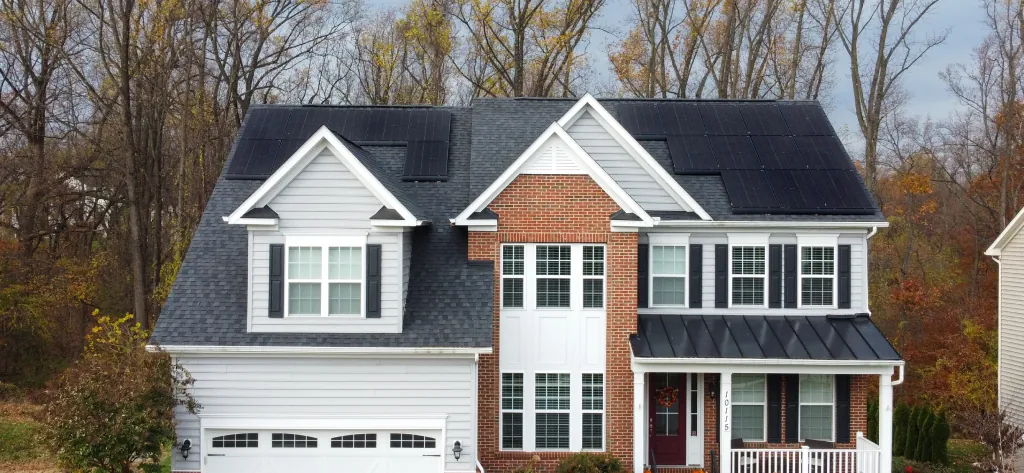Article
How Net Metering Works in Maryland

When you install solar panels on your property, you may have the opportunity to sell excess energy back to your utility company to further reduce your monthly bills through net energy metering. Both homeowners and renters in Maryland can enjoy the perks of net metering by installing solar panel arrays that meet the state’s compliance standards.
What is Net Metering?
Net metering is a billing arrangement between utility companies and homeowners or renters in Maryland who use solar panels to generate their own electricity. Let’s say you install a solar panel system on your roof that produces more electricity during the day than you consume at night. That extra power will return to the grid, and your utility provider will credit the difference to your account.
Different net metering systems exist to ensure that as many people as possible can enjoy the perks. Maryland residents can subscribe to community solar projects to reap the rewards of virtual net metering, in which they can receive credits for off-site energy generation. While some states use the term “aggregate net metering” to define these community-based systems, aggregate programs in Maryland refer to those designed for agricultural facilities, non-profit organizations, and government agencies.
Maryland’s Net Energy Metering Law
Maryland originally passed net-metering legislation in 1997 but has updated numerous aspects to keep up with growing renewable energy initiatives. Maryland Code §7-306 defines the parameters of this program. Here are some of the key takeaways:
- Statewide net-energy metering capacity limit: 3,000 megawatts
- Individual system capacity limit: 5 megawatts or 200% of annual usage
- Monthly utility credit: Full retail value
- Annual utility credit: Average commodity rate for electricity
In other words, each residential system is limited to 5 MW or 200% of a customer’s annual electricity usage. The statewide program is first-come, first-served until it reaches capacity at 3,000 MW. All utility companies in Maryland that can send and receive electricity participate in the program, meaning all customers should have the opportunity to enjoy the rewards.
Benefits of Net Metering for Maryland Homeowners
There’s a lot to love about Maryland’s net-metering program. Here are some of the benefits you can look forward to:
Financial Benefits
Residents generating ample electricity can lower their energy bills and minimize monthly costs. In fact, you may be eligible for savings through federal and state tax incentives in addition to reduced electricity bills.
Environmental Benefits
According to the Renewable Energy Portfolio Standard, Maryland plans for a minimum of 14.5% of statewide electricity to come from solar energy by 2028, and net metering is a big part of that initiative.
This program can help you make the most of your solar investment, especially during sunny months when you generate more energy than you use. It also serves the larger purpose of supporting Maryland’s renewable energy benchmarks and reducing the state’s reliance on fossil fuels.

How to Switch to Solar in 5 Simple Steps
How to Get Started with Net Metering
Ready to start saving with solar net metering in Maryland? Here’s a guide to the process:
Installing Solar Panels for Net Metering
Before you begin collecting, storing, and selling solar energy back to your utility company, you need to complete a few key steps. Begin by contacting a reputable solar installation expert who can perform a comprehensive cost-benefit analysis. This assessment will help you understand your energy needs and the number of solar panels required to generate the appropriate amount of power.
Next, have a structural engineer inspect your roof and determine its load-bearing capacity. They will assess the age of your roof, its anticipated lifespan, and how much weight it can support. These experts can tell you whether your roof is capable of supporting your potential solar panel system or if you’ll need to reinforce or replace your existing structure.
Once you have a better understanding of your roof’s integrity, it’s time to contact your trusted solar installer for a site assessment. During this meeting, your technician will measure your roof’s dimensions and obtain any necessary state and local permits.
Most solar installations take two to three days to complete. When your system is fully installed, your solar company will perform a system inspection to ensure everything is working correctly.
The solar installation company you choose can significantly impact your overall experience and outcome. A reputable professional should be familiar with net metering requirements in Maryland to help you navigate the process and meet all compliance standards.
Registering with Your Utility Provider
Once your solar panel array is up and running, you’ll need to enroll in your utility company’s net-metering program to start enjoying additional savings. This process can vary by utility company, so reach out to your provider for detailed information. You must also register with the Maryland Public Service Commission (PSC), which will send you a Solar Photovoltaic System Certification verifying that your setup is interconnected and approved for net metering.
Commercial enterprises hoping to sell their excess Renewable Energy Certificates (RECs) must register for PJM Interconnection’s Generator Attribute Trading System (GATS) within 30 days of receiving their certification from Maryland PSC in order to manage and sell their certificates. Companies looking to lower their environmental impact buy RECs to offset their use of fossil fuels and other non-renewable energy sources. Each REC equals one megawatt-hour.
Of course, A great solar installation expert can guide you through the process or even do some of the work for you. When you hire Solar Energy World to install your solar panel array, we will set up the final inspection with your municipality or utility company and complete the paperwork for solar tax credits and any applicable rebate programs, so you don’t have to.
Installing a Bidirectional Meter
In order to reap the benefits of net metering in Maryland, your solar panel array must include a bidirectional meter, a device that can measure energy flow in two directions. This meter accurately records the power you use from the grid as well as the excess energy you send back to the system.
Understanding Contracts, Billing Cycles, and Energy Credits
In Maryland, net metering credits roll over each month, so you can enjoy the payoff throughout more overcast seasons. Any remaining balance must be reconciled at the end of the fiscal year.
Many solar installers offer live monitoring services to help you better understand your system’s overall performance and visualize input and output trends.
Because the state limits the size of solar panel arrays, most residential systems won’t generate enough energy to sell RECs. Instead, the difference is automatically applied to your utility bill. According to the Solar Energy Industries Association, only 20% to 40% of solar energy generated is ever returned to the grid, but that excess energy can lead to more money in your pocket.
Explore Solar Energy Savings in Maryland
Net metering allows Maryland residents to maximize the benefits of their solar panel array and get the biggest return on their investment. Installing an approved system can reduce your energy costs and allow you to support the state’s efforts toward renewable energy.
Solar Energy World is dedicated to helping more people harness the power of the sun. Contact us today to schedule a free solar estimate and begin your journey to a more sustainable future! g coverage options, potential premium adjustments, and necessary questions for your insurer, you can make informed decisions to protect your investment.
Want a Free Solar Estimate?
Fill out the form to get started today.

